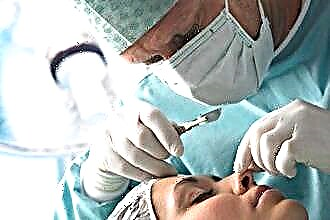Adenoids (enlarged pharyngeal tonsil) are small formations of lymphoid tissue that produce immune cells. With the frequent development of respiratory diseases, the immune organ increases in size, which inevitably leads to blockage of the nasal passages and, accordingly, difficulty in breathing. If the overgrown adenoid tissue covers more than 1/3 of the nasopharynx, the patient is prescribed surgical treatment, i.e. adenotomy. Can adenoids grow back after surgery and rehabilitation?
Surgical intervention is a radical, but still symptomatic method of treating pathology. Surgical operation allows you to directly eliminate adenoid growths, but not the cause of their occurrence. In addition, allergies, chronic rhinitis, secondary immunodeficiencies and a number of other reasons can provoke the re-development of the disease.
Why do adenoids appear?
 Adenoids or adenoid growths are called a slightly enlarged pharyngeal tonsil, which is located in the nasopharynx. The active development of the organ is observed only in the third year of a child's life during the formation of the body's defense system. In the glandular tissues of the tonsil, immunoglobulin (antibodies) is produced, which prevent the multiplication of viruses, fungi and bacteria.
Adenoids or adenoid growths are called a slightly enlarged pharyngeal tonsil, which is located in the nasopharynx. The active development of the organ is observed only in the third year of a child's life during the formation of the body's defense system. In the glandular tissues of the tonsil, immunoglobulin (antibodies) is produced, which prevent the multiplication of viruses, fungi and bacteria.
The main reason for the appearance of adenoid vegetations is frequent exacerbations of infectious diseases that arise due to a decrease in immunity.
Due to the constant attacks of pathogens, the immune system begins to work in an enhanced mode. With the development of inflammation in the nasopharynx, the amygdala increases in size, which indicates an intensive production of protective cells. At the stage of recovery, the size of the immune organ decreases, but with a sluggish or frequent development of infections, the adenoids only grow, which leads to blockage of the nasal passages.
Do you need an operation?
Many parents mistakenly believe that any disease can be cured with the help of drugs, but this is not the case. It should be understood that an overgrown amygdala is not edema or inflammation, which can dissolve over time. Adenoid vegetation - formed tumors that cannot be eliminated with anti-inflammatory and vasoconstrictor agents.
It is quite another matter when it comes to inflammation of the immune organ, i.e. adenoiditis. With the development of an infectious disease, the adenoids really increase in size due to inflammation and swelling of the tissues. For this reason, the treatment of adenoiditis may be limited to medication and physiotherapy.
If the adenoids are slightly enlarged and do not interfere with normal nasal breathing, doctors do not recommend an adenotomy. However, with the development of complications caused by a strong proliferation of the immune organ, one cannot refuse surgical treatment. If the problem is ignored, children often develop chronic rhinitis, otitis media, sinusitis, etc.
Indications for surgery
Operations to remove adenoids are performed in all medical facilities where there is an otolaryngology department. The simple procedure takes no more than 15 minutes, after which the patient is allowed to go home almost immediately. The success of treatment depends on the implementation of the rules of postoperative therapy, which consists in following a gentle diet and taking antimicrobial agents.
What are the indications for adenotomy? Surgical intervention is justified only if the following indications are present:
- lack of effect from drug therapy;
- 2 and 3 stages of development of adenoid vegetation;
- the appearance of complications (otitis media, sinusitis, chronic rhinitis);
- absolute obstruction of the nasal passages;
- changes in the structure of the tissues of the nasopharynx.
It is impossible to carry out adenotomy in case of impaired blood clotting, leukemia (blood cancer) and diseases of the cardiovascular system.
The overgrown amygdala becomes a breeding ground for infection, so its removal in a sense helps to increase immunity. If the congestion of the nasal passages is not eliminated in time and the adenoid vegetations are not cut out, this can even lead to a change in the shape of the lower jaw and, accordingly, to a violation of the bite.
Reasons for re-hypertrophy
 Do adenoids grow after removal? In most cases, the re-development of adenoid vegetations is not observed, however, there are exceptions. Sometimes the surgeon deliberately leaves part of the glandular tissue in order to maintain local immunity in the nasopharynx. Allergic rhinitis and frequent recurrences of acute respiratory infections create an excessive infectious load on the respiratory system, which can cause a repeated increase in the size of the amygdala.
Do adenoids grow after removal? In most cases, the re-development of adenoid vegetations is not observed, however, there are exceptions. Sometimes the surgeon deliberately leaves part of the glandular tissue in order to maintain local immunity in the nasopharynx. Allergic rhinitis and frequent recurrences of acute respiratory infections create an excessive infectious load on the respiratory system, which can cause a repeated increase in the size of the amygdala.
The likelihood of secondary development of ENT disease depends on several factors, namely:
- the quality of the adenotomy - even a few millimeters of the remaining lymphoid tissue can lead to the proliferation of the adenoids;
- the age of the patient, the lower the age of the patient, the higher the likelihood of a relapse of the disease; therefore, adenotomy is recommended for children from 3-4 years of age;
- tendency to allergies - regular inflammation and swelling of the nasopharynx contributes to irritation of the mucous membrane and pathological development of glandular tissues;
- the presence of endocrine diseases - instability of the hormonal background and malfunctions of the thymus (thyroid) gland negatively affect the immune system and the functioning of immune organs, in particular the pharyngeal tonsil.
Most often, relapses of the disease are observed when the nasopharyngeal tonsil is removed with an ordinary adenotome, i.e. ring-shaped scissors.
As practice shows, the repeated growth of the amygdala leads to an even greater increase in the volume of lymphadenoid tissue. Therefore, if neoplasms are found, it is necessary to re-conduct surgical treatment.
When to remove adenoids?
When is it more expedient to carry out an operation to remove the tonsil? There are favorable and unfavorable periods for surgical intervention. The process of a child's physical development is conventionally divided into 2 phases:
- "Stretching" - active development and growth of the body in length;
- “Rounding off” means a slowdown in development and, accordingly, growth.
Experts have noticed that when the tonsils are excised during the period of rapid development of the body, the re-formation of a benign tumor is observed in 35% of cases. In this regard, the most favorable time for the operation is the age from 5 to 6 and from 13 to 14 years - the "rounding" phase.
Reduction, i.e. simplification or atrophy of the pharyngeal tonsil, begins at the age of 8-9 years. In most cases, the immune organ is almost completely absorbed after puberty. That is why adenoids are most often diagnosed in preschool children. To reduce the likelihood of repeated hypertrophy (enlargement) of the amygdala, it is necessary to provide a satisfactory state of immunity.
Postoperative care
How to prevent re-formation of adenoids after adenotomy? Tonsil hypertrophy can be prevented if the ENT doctor's instructions for rehabilitation are followed. For a week after adenotomy, it is undesirable to bathe the child in hot water, as this can lead to vasodilation and, accordingly, bleeding at the site of the operated tissues.
It is possible to speed up the healing of the nasopharynx and prevent its purulent inflammation with the use of drugs such as:
- antibiotics - Flemoxin Solutab, Augmentin, Ampicillin;
- vasoconstrictor drops - "Sanorin", "Naphtizin", "Nazol";
- anti-inflammatory drugs - "Ibuprofen", "Ketorol", "Nise";
- antiallergic drugs - "Tavegil", "Suprastin", "Chloropyramidine".

Hypothermia and prolonged exposure to the sun should be avoided for 1 month after adenotomy, as this can lead to complications and sometimes re-development of adenoids.
Drying and anti-allergic agents help relieve swelling from mucous membranes and facilitate breathing through the nose. Thus, stagnation of mucus in the nasopharynx is prevented and the likelihood of inflammation, which stimulates the proliferation of lymphoid tissues, is reduced.
Adenoiditis and Hypertrophy
 Surgical intervention is required not only with a strong proliferation of the adenoids, but also with their inflammation. But before resorting to surgical treatment, it is necessary to carry out drug therapy and eliminate inflammation in the respiratory organs. If this is not done, most likely, the amygdala will grow again, as the immune system tends to increase the body's resistance to the invasion of pathogenic microbes and viruses.
Surgical intervention is required not only with a strong proliferation of the adenoids, but also with their inflammation. But before resorting to surgical treatment, it is necessary to carry out drug therapy and eliminate inflammation in the respiratory organs. If this is not done, most likely, the amygdala will grow again, as the immune system tends to increase the body's resistance to the invasion of pathogenic microbes and viruses.
With adenoiditis, inflammation is observed not only of the immune organ, but also of the surrounding tissues. For this reason, it is almost impossible to completely remove the hypertensive (overgrown) tonsil. Due to the presence of inflammation in the nasopharynx, the adenoid tissue grows again, which leads to a relapse of the pathology.
Adenotomy can be performed only in case of 100% elimination of purulent and catarrhal inflammation of the upper respiratory tract.
Etiological factors
Adenotomy is a symptomatic method of treating a disease that eliminates only the consequence of pathological processes in the respiratory organs. To prevent the re-development of adenoid vegetations, it is necessary to determine and eliminate the causes of their formation. Most often, tonsil hypertrophy is caused by:
- allergic reactions;
- secondary immunodeficiencies;
- unfavorable environmental conditions;

- frequent relapses of infections;
- bad habits (smoking).
To reduce the likelihood of re-formation of adenoids, all provoking factors must be excluded. In children, adenoids often occur against the background of acute respiratory viral infections, scarlet fever, measles, flu, tonsillitis and sinusitis. Infectious diseases lead to inflammation of the paranasal sinuses and nasopharyngeal mucosa. The congestion of viscous secretions in the nasal cavity is a key link in the trigger mechanism that stimulates the formation of benign tumors.
Prevention
Immunostimulating therapy is the best prevention of adenoids in children. Medicines for stimulating immunity give an impulse to activate defense mechanisms. There are several types of immunostimulating drugs that are used after adenotomy to prevent hypertrophy of adenoid tissue:
- medicines of bacterial origin;
- interferon preparations;
- nucleic acid drugs;
- fortified products.
Immunostimulants prevent the development of inflammation, which provokes the growth of the pharyngeal tonsil.
To increase the body's immune forces, the following means can be used:
| Drug name | Active ingredients | Appointment |
|---|---|---|
| "Laferobion" | leukocyte interferon | prevents bacterial and viral tissue inflammation, prevents the formation of tumors |
| "Cycloferon" | acridoneacetic acid | stimulates the production of natural interferon, thereby increasing overall immunity |
| "Afinitor" | everolimus | prevents the production of DNA and RNA of pathogens, as a result of which the likelihood of inflammation of the respiratory system is reduced |
| "Engystol" | sulphur and gusset extract | increases the activity of immune cells, which leads to a strengthening of the immune system |
| "Anaferon" | sodium sterate, leukocyte interferon | promotes the production of interferon, which destroys the cells of pathogenic bacteria and viruses |
According to medical data, with preventive measures, the risk of re-development of the disease is reduced by 25%. In addition, immunostimulants are recommended for use in anticipation of seasonal respiratory diseases such as influenza, allergies, SARS, etc.




